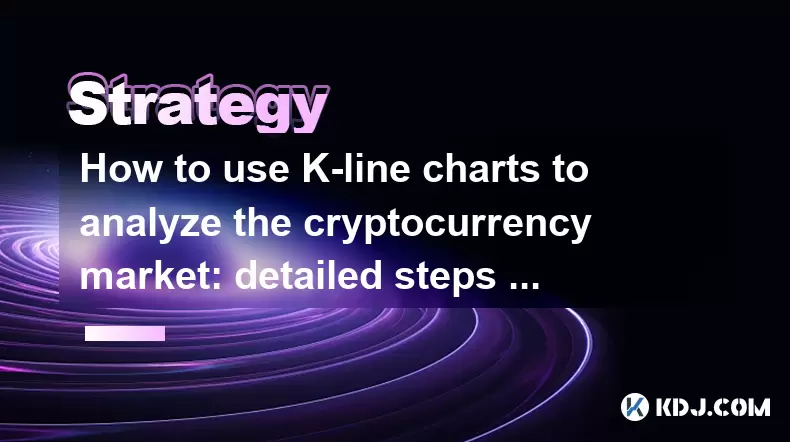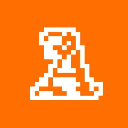-
 bitcoin
bitcoin $122090.672462 USD
1.59% -
 ethereum
ethereum $4493.758974 USD
0.56% -
 xrp
xrp $3.033145 USD
0.65% -
 tether
tether $1.000629 USD
0.00% -
 bnb
bnb $1169.854250 USD
7.07% -
 solana
solana $230.954786 USD
-0.19% -
 usd-coin
usd-coin $0.999785 USD
0.00% -
 dogecoin
dogecoin $0.256108 USD
-1.12% -
 tron
tron $0.342333 USD
-0.12% -
 cardano
cardano $0.859632 USD
-0.10% -
 hyperliquid
hyperliquid $48.932146 USD
-2.25% -
 chainlink
chainlink $22.345466 USD
-1.29% -
 ethena-usde
ethena-usde $1.000217 USD
-0.03% -
 avalanche
avalanche $31.203456 USD
1.93% -
 sui
sui $3.579145 USD
1.05%
How to use K-line charts to analyze the cryptocurrency market: detailed steps and common misunderstandings
K-line charts are essential in crypto trading, visually showing price action through patterns like bullish/bearish engulfing and hammers to help predict trend reversals and continuations.
Jun 16, 2025 at 01:42 pm

Understanding the Basics of K-line Charts in Cryptocurrency Trading
K-line charts, also known as candlestick charts, are one of the most widely used tools for analyzing price movements in financial markets, including cryptocurrencies. These charts provide a visual representation of price action over specific time intervals and help traders make informed decisions based on patterns and trends.
Each K-line, or candlestick, represents four key pieces of information: open price, close price, high price, and low price within a given timeframe. The body of the candle shows the range between the open and close, while the wicks (or shadows) indicate the highest and lowest prices reached during that period.
In the context of cryptocurrency trading, understanding how to interpret these candles is crucial because crypto markets operate 24/7 and can be highly volatile. Properly reading K-lines allows traders to identify potential reversals, continuations, and support/resistance levels.
Step-by-Step Guide to Reading K-line Patterns
To effectively use K-line charts, you must first learn how to recognize common candlestick patterns and what they signify in terms of market sentiment.
- Bullish Engulfing Pattern: This occurs when a small bearish candle is followed by a larger bullish candle that completely engulfs the previous candle’s range. It suggests a potential reversal from a downtrend to an uptrend.
- Bearish Engulfing Pattern: The opposite of the bullish engulfing pattern, this indicates a possible reversal from an uptrend to a downtrend.
- Hammer and Hanging Man Candles: Both have small bodies with long lower wicks. A hammer appears during a downtrend and signals a potential reversal upwards. A hanging man appears during an uptrend and may signal a reversal downwards.
- Shooting Star and Inverted Hammer: These candles have small bodies and long upper wicks. A shooting star appears at the top of an uptrend and signals a possible reversal down, while an inverted hammer occurs at the bottom of a downtrend and may signal a reversal up.
These patterns become more reliable when they appear near significant support or resistance levels. Combining them with volume analysis can further confirm the strength of the signal.
Selecting the Right Timeframe for Your Analysis
Choosing the correct timeframe is essential when using K-line charts for cryptocurrency trading. Different timeframes offer varying levels of detail and insight into market behavior.
For day traders, shorter timeframes such as 5-minute, 15-minute, or 1-hour charts are typically used. These allow for quick entry and exit points but can be noisy and subject to false signals.
Swing traders often rely on 4-hour or daily charts, which filter out some of the short-term volatility and highlight stronger trends. Long-term investors might focus on weekly or monthly charts to understand broader market cycles.
It's important to analyze multiple timeframes to get a comprehensive view. For example, if you're considering entering a trade based on a daily chart pattern, checking the 4-hour chart can help determine optimal entry timing.
Common Misinterpretations of K-line Signals
Many traders fall into the trap of misinterpreting K-line signals due to a lack of context or confirmation from other indicators.
One common mistake is trusting every candlestick pattern without waiting for confirmation. Just because a bullish engulfing pattern forms doesn’t mean the trend will reverse immediately. Often, it takes a few more candles to confirm the new direction.
Another misunderstanding involves ignoring the market context. A hammer candle might look promising on its own, but if it appears in a strong downtrend with no nearby support level, it may not carry much weight. Always assess where the pattern is occurring relative to key price zones.
Additionally, many traders fail to incorporate volume analysis alongside K-line patterns. High volume accompanying a reversal pattern increases its reliability. Conversely, a pattern forming on low volume should be treated with caution.
Lastly, some traders assume that all candlestick patterns are equally effective across different assets and timeframes. In reality, their success rate varies depending on the asset's liquidity, volatility, and the overall market environment.
Combining K-line Charts with Other Technical Indicators
While K-line charts are powerful on their own, combining them with other technical indicators enhances decision-making accuracy and reduces false signals.
The Relative Strength Index (RSI) is often used to confirm overbought or oversold conditions. If a bearish engulfing pattern forms and RSI is above 70, it strengthens the case for a potential reversal.
Moving averages, particularly the 50-day and 200-day moving averages, can help identify the overall trend. When a bullish K-line pattern appears above both moving averages, it reinforces the likelihood of a continuation rather than a reversal.
Volume indicators like On-Balance Volume (OBV) or Chaikin Money Flow can also provide insights into whether buying or selling pressure is increasing. If a bullish pattern forms alongside rising volume, it adds credibility to the setup.
Some traders also use Fibonacci retracement levels to pinpoint areas where K-line patterns might carry more significance. A pin bar forming at a 61.8% retracement level is often considered a stronger signal than one appearing randomly in the middle of a trend.
Frequently Asked Questions
Q: Can K-line charts be used for all cryptocurrencies?Yes, K-line charts apply universally to any cryptocurrency traded on exchanges. However, less liquid or newer altcoins may produce misleading patterns due to thin order books and erratic price swings.
Q: Should I rely solely on K-line charts for trading decisions?No single tool should be used in isolation. While K-line charts offer valuable insights into price action, combining them with volume, moving averages, and broader market sentiment improves accuracy.
Q: Do K-line patterns work better on certain timeframes?Patterns tend to be more reliable on higher timeframes like 4-hour or daily charts. Lower timeframes generate more noise and frequent false signals, requiring stricter filtering.
Q: Are K-line charts suitable for beginners?Absolutely. Beginners can start by learning basic patterns and gradually build complexity. Practice on demo accounts helps reinforce understanding without real money risk.
Disclaimer:info@kdj.com
The information provided is not trading advice. kdj.com does not assume any responsibility for any investments made based on the information provided in this article. Cryptocurrencies are highly volatile and it is highly recommended that you invest with caution after thorough research!
If you believe that the content used on this website infringes your copyright, please contact us immediately (info@kdj.com) and we will delete it promptly.
- BlockDAG, DOGE, HYPE Sponsorship: Crypto Trends Shaping 2025
- 2025-10-01 00:25:13
- Deutsche Börse and Circle: A StableCoin Adoption Powerhouse in Europe
- 2025-10-01 00:25:13
- BlockDAG's Presale Buzz: Is It the Crypto to Watch in October 2025?
- 2025-10-01 00:30:13
- Bitcoin, Crypto, and IQ: When Genius Meets Digital Gold?
- 2025-10-01 00:30:13
- Stablecoins, American Innovation, and Wallet Tokens: The Next Frontier
- 2025-10-01 00:35:12
- NBU, Coins, and Crypto in Ukraine: A New Yorker's Take
- 2025-10-01 00:45:14
Related knowledge

Practical parameter settings for a Bitcoin multi-timeframe moving average system
Sep 18,2025 at 10:54pm
Optimizing Timeframe Combinations for Bitcoin Trading1. Selecting appropriate timeframes is crucial when building a multi-timeframe moving average sys...

How can I filter out false breakouts in Dogecoin high-frequency trading?
Sep 22,2025 at 01:00am
Understanding False Breakouts in Dogecoin Trading1. A false breakout occurs when Dogecoin's price appears to move beyond a defined support or resistan...

Techniques for identifying tops and bottoms in the Bitcoin on-chain NVT model
Sep 20,2025 at 07:54pm
Understanding the NVT Model in Bitcoin Analysis1. The Network Value to Transactions (NVT) ratio is often described as the 'P/E ratio' of the cryptocur...

What does the surge in open interest in Bitcoincoin futures mean?
Sep 20,2025 at 11:18pm
Understanding the Surge in Dogecoin Futures Open Interest1. A surge in open interest within Dogecoin futures indicates a growing number of active cont...

How can I use the Ethereum USDT premium to gauge market sentiment?
Sep 18,2025 at 11:55pm
Understanding the Ethereum USDT Premium1. The Ethereum USDT premium refers to the price difference between USDT (Tether) traded on Ethereum-based plat...

What should I do if Ethereum staking yields decline?
Sep 20,2025 at 06:18am
Understanding the Causes Behind Declining Ethereum Staking Yields1. The Ethereum network transitioned to a proof-of-stake consensus mechanism with the...

Practical parameter settings for a Bitcoin multi-timeframe moving average system
Sep 18,2025 at 10:54pm
Optimizing Timeframe Combinations for Bitcoin Trading1. Selecting appropriate timeframes is crucial when building a multi-timeframe moving average sys...

How can I filter out false breakouts in Dogecoin high-frequency trading?
Sep 22,2025 at 01:00am
Understanding False Breakouts in Dogecoin Trading1. A false breakout occurs when Dogecoin's price appears to move beyond a defined support or resistan...

Techniques for identifying tops and bottoms in the Bitcoin on-chain NVT model
Sep 20,2025 at 07:54pm
Understanding the NVT Model in Bitcoin Analysis1. The Network Value to Transactions (NVT) ratio is often described as the 'P/E ratio' of the cryptocur...

What does the surge in open interest in Bitcoincoin futures mean?
Sep 20,2025 at 11:18pm
Understanding the Surge in Dogecoin Futures Open Interest1. A surge in open interest within Dogecoin futures indicates a growing number of active cont...

How can I use the Ethereum USDT premium to gauge market sentiment?
Sep 18,2025 at 11:55pm
Understanding the Ethereum USDT Premium1. The Ethereum USDT premium refers to the price difference between USDT (Tether) traded on Ethereum-based plat...

What should I do if Ethereum staking yields decline?
Sep 20,2025 at 06:18am
Understanding the Causes Behind Declining Ethereum Staking Yields1. The Ethereum network transitioned to a proof-of-stake consensus mechanism with the...
See all articles










































































